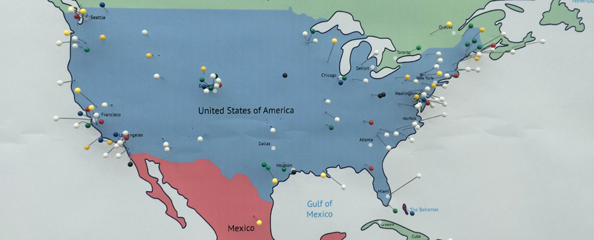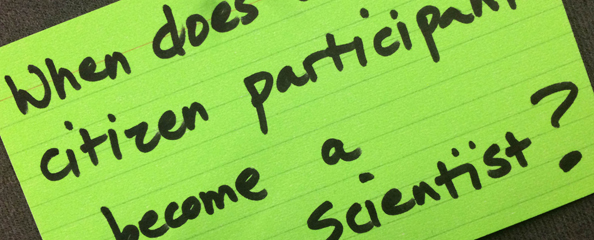2015 Citizen Science Association Inaugural Conference: Updates From The Field
Citizen science describes data collection efforts by volunteers (who are often not professional scientists) to advance scientific inquiry. Other outcomes may occur as a result of citizen science projects—including participants learning more about particular disciplines, the co-creation of research questions, and solving problems important to local communities. While these few sentences characterize citizen science, it is a very diverse field that is rapidly growing and gaining prominence in scientific research and STEM education communities. These ideas, and more, were explored, explained and discussed at the inaugural conference of the newly-launched Citizen Science Association on February 11 and 12 in San Jose, CA. While the notion of an Association has been in the works for years, and prior meetings have explored topics around citizen science, this was the first time that scientists, educators, learning researchers, volunteers, evaluators, technology specialists, and others came together to discuss what it will take to support a collaborative community of practice around citizen science. The conference explored themes such as research and evaluation in citizen science, supporting lifelong learning, broadening participation, and tackling grand challenges and everyday problems related to science and society. Presentations highlighted a wide range of projects that employed many varieties of data collection--from monitoring water quality to documenting new insect species in urban Los Angeles to mapping brain cells through an interactive game. While there are few generalizations that can be made about citizen science at the conference, here are a few of my impressions from participating in the discussions.
Key Takeaways
This is a global movement. There were over 600 attendees at the conference from 25 countries, representing projects and programs happening across the globe. In just a few sessions, I heard presentations from work being done in New Guinea, Kyrgyzstan, New Zealand, the Bahamas, England, and Micronesia. While the new Citizen Science Association has no geographic restrictions on membership, there are also citizen science associations in Europe and Australia. Citizen science projects have the power to operate globally and locally, and infrastructure that the Association is developing will support networking, sharing of best practices, and in the the future, possibly even data and methods. Measuring engagement in citizen science is a developing and important subfield. Lots of sessions addressed what it means for volunteers and scientists to be “engaged” in their work. Each project may define “engagement” differently—and, as Tina Phillips noted in her session (“Unpacking What it Means to be a Citizen Scientist: Toward a Shared Understanding for Defining and Measuring Engagement”), projects need to define what they mean by engagement before they can evaluate their success. In a related session (“How Does Participation Matter?” Participation, Empowerment and Development of Science Identity”), Heidi Ballard described how citizen science can lead to increased self-efficacy (i.e. confidence in one’s ability to “do science”) as one way to measure of engagement. Another measure of engagement might be in evaluating the increase in participants’ knowledge of a particular discipline and related resarch methodology, as in the COASST project presented by Cynthia Char (“Promoting Rigorous Citizen Science: Evaluating the Learning Impact of the Coastal Observation and Seabird Survey”).
One of the "open-format" sessions proposed by an attendee.
Citizen Science can be a solution for many societal issues, but it’s not a magic bullet. In his keynote presentation that opened the conference, Dr. Chris Filardi of the American Museum of Natural History introduced the idea that through citizen science, local communities can envision a use and purpose for science inquiry through collaboration and even co-creation of projects. Citizen science also offers new opportunities for scientists to integrate culturally-competent practices into their work to advance common societal goals, like environmental conservation. There were many inspiring stories about this kind of work, such as a symposium on how Mi’kmaq First Nations citizens in Nova Scotia participated in an environmental monitoring project to prove that their local water supply had been contaminated in spite of years of being told otherwise by local authorities (“Our Ancestors are in the Water, Land and Air: Using an Integrative Approach of Indigenous and Western Research Methods for Community-Based Participatory Environment and Health Research”). However, even as the scientific community has become more accepting of volunteer and amateur data collection and increasingly mindful of citizen stakeholder concerns, citizen science is not the only solution to getting local populations more engaged in science issues, or trusting of the scientific process. In one memorable presentation, Stephen Gray shared survey data showing that fishermen who participated in co-created research projects with scientists actually showed less trust in science at the conclusion of the project than those who participated in purely collaborative or contributory projects (“How the Sausage is Made: When Public Participation in Science Leads to Decreased Trust of Scientific Assessment”).
How to Get Involved
At the close of the meeting, Association board members and attendees shared their takeaways from the two full days of presentations, poster sessions, and networking. Their observations and reflections included things like “citizen science is anytime, anywhere, anyone, and anything,” “this is a young community, but it’s growing fast and healthy,” “we are building a community of practitioners from disparate disciplines, but we are all working on the same thing,” and “changing the world is what matters, and it doesn’t matter who takes credit for it.” Although it was the end of the conference, there was a huge amount of excitement and momentum in the room (in no small part in response to an inspring closing keynote by Amy Robinson of Eyewire). At the closing it was clear that participants were resonating with Association Board Member Rick Bonney’s opening remarks on the first day: that attendees had gathered to celebrate a revolution, which is the idea that anyone, regardless of training, can be a meaningful part of scientific discovery. The next Citizen Science Association conference will be held in 2017 (dates and location TBD), but there will be lots of activity in the meantime. The Association is organizing working groups, launching a new journal (Citizen Science: Theory and Practice), and hosting listservs (for discussion and news/announcements). They have already brought together 3,000 members—joining (which is free of charge) is the best way to keep up-to-date on Association activities.
Related Resources
Advancing Citizen Science: a Q&A with Caren Cooper
Our interview with the new Citizen Science Association
Public Participation in Science Research: a CAISE Inquiry Group Report
Public Participation in Scientific Research: 2012 Conference Evaluation